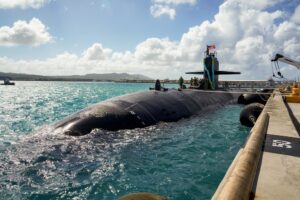The Pentagon has concluded its new Global Posture Review (GPR) assessing how its forces and resources are deployed around the world, to include enhancing infrastructure in Australia and Guam with the department’s increased focus on the Indo-Pacific region.
Mara Karlin, the acting deputy under secretary of defense for policy, noted, however, that much of the posture review’s specific findings will remain classified.

“[The GPR] was a robust interagency effort. The Department of Defense led the GPR with participation and guidance from the National Security Council, the U.S. State Department, the U.S. Agency for International Development and the Office of the Director of National Intelligence. Additionally, the department conducted Global Posture Review consultations with our NATO Allies, Australia, Japan, the Republic of Korea and over a dozen partners across the Middle East and Africa to ensure we were bringing the full spectrum of views to the table,” Karlin said during a press briefing.
Defense Secretary Lloyd Austin initiated the review in February to assess how the Pentagon would align its global footprint with the Biden administration’s national security guidance, with the process moving forward as the department detailed a focus on China as a “pacing threat” and the U.S.’ withdrawal from Afghanistan.
“Based on these assessments, the GPR developed near-term posture adjustments and established guidance for ongoing and future posture planning. It also strengthened DoD’s decision making processes by deliberately connecting global posture planning and decisions to strategic priorities, tradeoffs across geographic regions, force readiness, modernization, interagency coordination and allied and partner consultations,” Karlin said. “Many of the Global Posture Review outcomes remain classified for operations security reasons and to protect the confidentiality of our consultations with allies and partners.”
Karlin, however, was able to provide some specific insight on how the GPR informed plans for additional cooperation with allies and partners in the Indo-Pacific “to advance initiatives that contribute to regional stability and deter potential military aggression from China and threats from North Korea.”
“In Australia, you’ll see new rotational bomber and fighter aircraft deployments. You’ll see ground forces training and increased logistics cooperation. And, actually, more broadly across the Indo-Pacific you’ll see a range of infrastructure improvements in Guam, the Commonwealth of the Northern Mariana Islands and Australia. Those will include things, more broadly, like logistics facilities, fuel storage, munitions storage, airfield upgrades. So we’re doing a lot that will hopefully come to fruition in the coming years,” Karlin said.
The focus on the Indo-Pacific as a priority region has included the U.S.’ recent formation of the new AUKUS trilateral security partnership with the U.K. and Australia, which involves assisting Australia’s pursuit of nuclear-powered submarines (Defense Daily, Sept. 15).
For Europe, Karlin said the review identified additional capabilities that will enhance U.S.’ deterrence posture, while not providing specifics on what may be involved.
“The Global Posture Review strengthens the combat-credible deterrent against Russian in Europe and enables NATO forces to operate more effectively,” Karlin said, noting Austin’s previous decision to station a new Army Multi-Domain Task Force and Theater Fires Command in Germany.
In the Middle East, Karlin noted, the GPR calls on Pentagon officials to continue assessing enduring posture requirements in further consultations with partners and allies in the region.
“The Global Posture Review assessed our evolving counterterrorism requirements along with the end of DoD operations in Afghanistan and our approach toward Iran. In Iraq and Syria, the Global Posture Review directs that DoD posture will continue to support the Defeat ISIS campaign and building the capacity of our partner forces,” Karlin said.